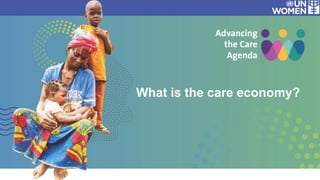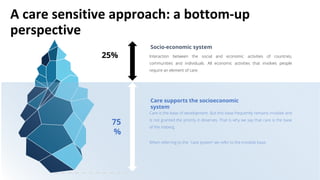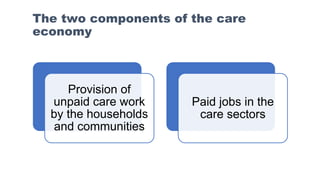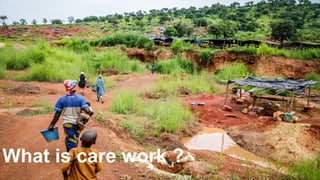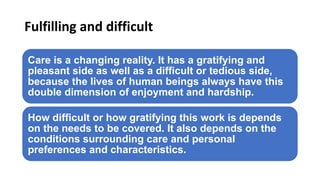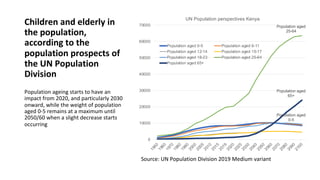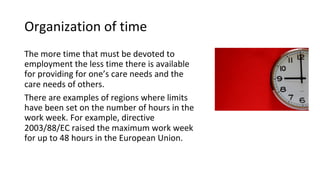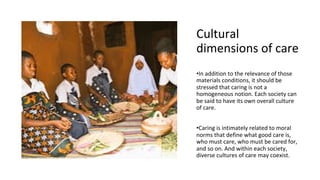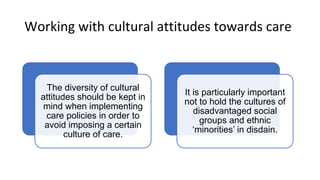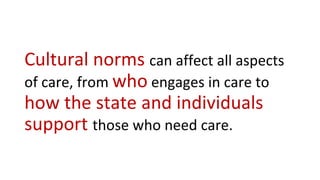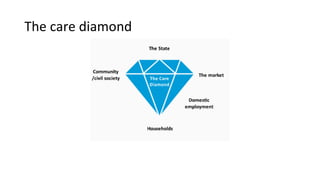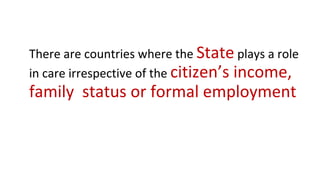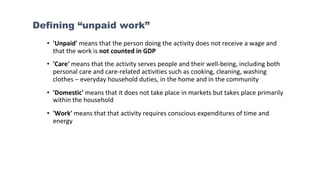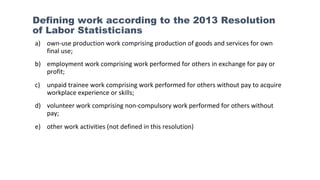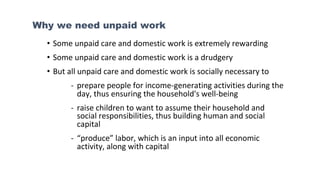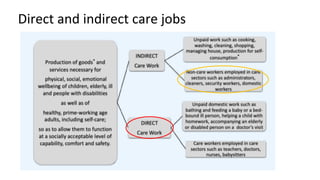What is the care economy_United Nation Women.pdf
- 1. What is the care economy?
- 2. Socio-economic system Interaction between the social and economic activities of countries, communities and individuals. All economic activities that involves people require an element of care. Care supports the socioeconomic system Care is the base of development. But this base frequently remains invisible and is not granted the priority it deserves. That is why we say that care is the base of the iceberg. When referring to the ‘care system’ we refer to the invisible base. 25% 75 % A care sensitive approach: a bottom-up perspective
- 3. The two components of the care economy Provision of unpaid care work by the households and communities Paid jobs in the care sectors
- 4. What is care work ? care work? What is care work ?
- 5. Physical and emotional care • Care is comprised of all those activities necessary to re-create, day after day the physical and emotional well-being of people..
- 6. Components of care DIRECT CARE PRE-CONDITIONS FOR CARE MENTAL MANAGEMENT
- 7. Fulfilling and difficult Care is a changing reality. It has a gratifying and pleasant side as well as a difficult or tedious side, because the lives of human beings always have this double dimension of enjoyment and hardship. How difficult or how gratifying this work is depends on the needs to be covered. It also depends on the conditions surrounding care and personal preferences and characteristics.
- 8. Multi-faceted character of the motivation to care: One can take care of others out of love, but also because: One feels responsible for others It is seen as one’s job There are no alternatives Care is often provided free of charge (unpaid) in close networks involving care of family members, friends and neighbours.
- 9. When is care paid for… When care takes place in exchange for a salary, it can take place at home (domestic employment and home helpers) or in other locations such as residences for the elderly and inform and childcare centres. These paid positions are usually low paid and involve difficult work. There are also mixed formulas, for example, work carried out by volunteers in associations that look after the sick.
- 10. Changes in care needs over a lifetime At 12 years old, the situation varies greatly depending on whether the person is a girl or a boy, or from a worse-off or better-off family. While in some contexts at that age, a child’s only obligation is to attend school, in other (mainly girls) are expected to take responsibility for tasks such as washing and ironing clothes.. 12 years old Most people aged 42 years are able to take care of themselves and others. Often at this age, there are children, grandchildren and parents to care for. However, for men, it is likely that more time will be devoted to paid work and less to caring responsibilities. For women ,it is likely that caring responsibilities will be 42 years old Two year olds still need assistance with bathing, clothing eating and in many cases moving around/walking.. 2 years When aging, individuals might become senile and in need of total care, but it is just as possible that they are still working. If we are fortunate at this age one would be retired and receiving a pension, but at the same time might be doing unpaid care work, such as looking after grandchildren.. Women are less likely to receive a pension than men because the care work they perform during their lives does not entitle them to this benefit; they are also more likely to be taking care of others. 72 years old
- 11. SOCIAL DIMENSIONS OF CARE: DEMOGRAPHICS
- 12. Demography Children and the elderly the main recipients of care Women are most often caregivers
- 13. Children and elderly in the population Population ageing is happening globally, with the elderly forming a relatively high percentage of the population. On the African continent in general the majority on the population is still young. The population pyramid of the population of Kenya shows that the majority of the population is below 24 years of age. This means that at present the bulk of the care economy and care work has to be aimed at children. However, since fertility rates (number of children per woman) have been declining and life expectancy increase this will be changing in the coming decades. It is important to already start to think and prepare for the coming care economy needs of older people. Source: KNBS Population Census 2019
- 14. Children and elderly in the population, according to the population prospects of the UN Population Division Population ageing starts to have an impact from 2020, and particularly 2030 onward, while the weight of population aged 0-5 remains at a maximum until 2050/60 when a slight decrease starts occurring Source: UN Population Division 2019 Medium variant Population aged 0-5 Population aged 25-64 Population aged 65+ 0 10000 20000 30000 40000 50000 60000 70000 1 9 5 0 1 9 6 0 1 9 7 0 1 9 8 0 1 9 9 0 2 0 0 0 2 0 0 5 2 0 1 0 2 0 1 5 2 0 1 9 2 0 2 0 2 0 2 5 2 0 3 0 2 0 4 0 2 0 5 0 2 0 6 0 2 0 7 0 2 0 8 0 2 0 9 0 2 1 0 0 UN Population perspectives Kenya Population aged 0-5 Population aged 6-11 Population aged 12-14 Population aged 15-17 Population aged 18-23 Population aged 25-64 Population aged 65+
- 15. Care needs may change and increase unexpectedly e.g. during pandemics such HIV/AIDS and COVID-19
- 16. SOCIAL DIMENSIONS OF CARE: PUBLIC POLICY
- 17. A 1 2 3 INDIVIDUAL AND TEAM INTERACTIONS OVER PROCESSES AND TOOLS Is infrastructure adequate for care? Do housing, urban infrastructure and urban policies impact on care? Does sexual and reproductive policy recognize care needs? Public policies, particularly infrastructure policies, impact on care Key questions
- 18. SOCIAL DIMENSIONS OF CARE: THE LABOUR MARKET
- 19. Organization of time The more time that must be devoted to employment the less time there is available for providing for one’s care needs and the care needs of others. There are examples of regions where limits have been set on the number of hours in the work week. For example, directive 2003/88/EC raised the maximum work week for up to 48 hours in the European Union.
- 20. Cultural dimensions of care •In addition to the relevance of those materials conditions, it should be stressed that caring is not a homogeneous notion. Each society can be said to have its own overall culture of care. •Caring is intimately related to moral norms that define what good care is, who must care, who must be cared for, and so on. And within each society, diverse cultures of care may coexist.
- 21. Working with cultural attitudes towards care The diversity of cultural attitudes should be kept in mind when implementing care policies in order to avoid imposing a certain culture of care. It is particularly important not to hold the cultures of disadvantaged social groups and ethnic ‘minorities’ in disdain.
- 22. Discussion points on culture and care CHILDREN Child-care-taking is a major point of disagreement among cultures of care in the contemporary world. Some may think it is morally inadequate to ask a teenager to cook for the family. Others may expect it as a matter of course. MIGRANTS Learning how to answer to different notions of good care provision might involve significant effort on the part of migrant domestic employees. This effort ranges from cooking unfamiliar meals to clashing ideas on children’s education. Migration implies that diverse cultures of care come together. If appropriately managed, this can be mutually enriching; but if not, it can lead to misunderstandings
- 23. Cultural norms can affect all aspects of care, from who engages in care to how the state and individuals support those who need care.
- 24. The burden of care Once we have understood the care needs of a given context we need to understand how these needs are met. This means understanding: • Which actors take a role and assume responsibility for guaranteeing the care that society on the whole needs? • How do these different actors operate? • Which actors take on the greatest burden?
- 25. The care diamond
- 26. Challenges for organizing care 01 02 03 04 05 STATE and HOUSEHO LD In some countries the state participates significantly in providing care; in others the burden falls almost entirely on households. COMMODIFIED VS UNPAID In some societies care is paid for and sometimes at very high prices - in others paid care is not always available. SHIFTING COMPONENTS When clothes are bought and convenient foods consumed the nature of care and its components change. EXTENDED FAMILY AND COMMUNITY The community or extended family can play an important role in spreading care work. FEMINIZED OCCUPATIONS When care is paid for it is still an activity linked to women and undervalued.
- 27. One characteristic most care systems share… they are unjust
- 28. There are countries where the State plays a role in care irrespective of the citizen’s income, family status or formal employment
- 29. Defining “work” • The System of National Accounts (SNA) definition of work: ► SNA production boundary • All production of goods and services for the market (for pay or profit) and all production of goods for own final use by the households. Examples of care activities included in the GDP: • Processing crops (Agriculture) • Manufacturing clothing (Manufacturing) • Servicing corporate front offices (Professional, managerial, administrative) • Teaching (Education) • Nursing (Medicine) • Domestic work such as cooking, laundry performed by domestic workers • Caring for children (Child care) ► General production boundary: includes all production of services for own final use by the households and defined by the criterion of the third person, that is anything that one could theoretically pay someone else to do for you. Examples: • Preparing meals, laundering, ironing, cleaning performed by household members for their own use • Caring for children by mothers (or fathers or brothers/sisters) These are not included in GDP
- 30. Defining “unpaid work” • 'Unpaid' means that the person doing the activity does not receive a wage and that the work is not counted in GDP • 'Care' means that the activity serves people and their well-being, including both personal care and care-related activities such as cooking, cleaning, washing clothes – everyday household duties, in the home and in the community • 'Domestic' means that it does not take place in markets but takes place primarily within the household • 'Work' means that that activity requires conscious expenditures of time and energy
- 31. Defining work according to the 2013 Resolution of Labor Statisticians a) own-use production work comprising production of goods and services for own final use; b) employment work comprising work performed for others in exchange for pay or profit; c) unpaid trainee work comprising work performed for others without pay to acquire workplace experience or skills; d) volunteer work comprising non-compulsory work performed for others without pay; e) other work activities (not defined in this resolution)
- 32. Types of unpaid work • Direct active care: unpaid labor services provided directly to dependents on a face- to-face basis, where concern for the well-being of the care recipient is likely to affect the quality of the services provided • Direct active care is difficult to subject to commodification/economies of scale – e.g., not possible to read a bedtime story in 2 mins vs. 30 mins • Direct supervisory care: unpaid labor services that supervise dependents who cannot be safely left on their own • Indirect care: unpaid labour services that are inputs into direct care, but do not necessarily involve personal interactions, such as preparing meals or laundry • Historically, a driver of economic growth has been the transformation of unpaid care and domestic work into paid care work • Paid care work is found within the national accounts
- 33. Caring labor and its contents
- 34. There are huge gender inequalities when it comes to time spent on unpaid work ILO, 2019
- 35. The purple economy • Joan Tronto (2003): care is “a species of activity that includes everything we do to maintain, continue and repair our ‘world’ so that we can live in it as well as possible. That world includes our bodies, ourselves, and our environment, all of which we seek to interweave in a complex, life-sustaining web”. • The purple economy refers to an economic order organized around the sustainability of caring labour through a redistributive internalization of the costs of care • Similar to the green economy: organized around the sustainability of provisioning by nature through internalization of environmental costs into production and consumption patterns
- 36. The pillars of the purple economy
- 37. Why we need unpaid work • Some unpaid care and domestic work is extremely rewarding • Some unpaid care and domestic work is a drudgery • But all unpaid care and domestic work is socially necessary to - prepare people for income-generating activities during the day, thus ensuring the household's well-being - raise children to want to assume their household and social responsibilities, thus building human and social capital - “produce” labor, which is an input into all economic activity, along with capital
- 38. IMF | African Department 38 Beyond the unpaid care economy: the paid care sector
- 39. Direct and indirect care jobs
- 40. Direct and indirect care jobs Household Production: 16.4 billion hrs/day. performed by women (≈2 billion full-time jobs) 381 million workers 11.5% of global employment 2/3 are women
- 41. Thank you
